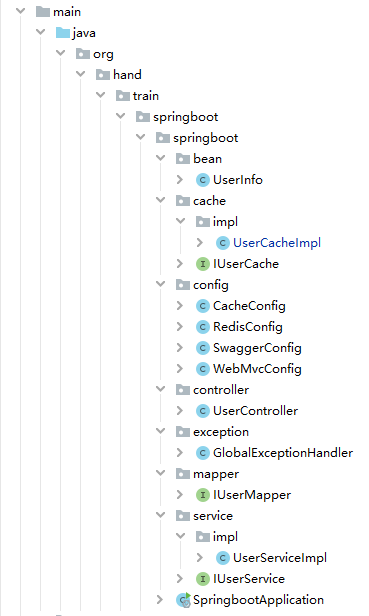Java SpringBoot Redis
前言
Redis安装参考
1、JavaBean对象缓存
I,SpringBoot提供的Redis缓存使用注解
A.@CachePut
B.@Cacheable
先从缓存中通过定义的键查询,如果可以查到数据,则返回,否则执行该方法,返回数据,并且将返回的结果保存到缓存中。
C.@CacheEvict
通过定义的键移除缓存,它有一个boolean类型的配置项beforeInvocation,表示在方法之前或者之后移除缓存。默认是false,所以默认为方法之后将缓存移除。
II,SpringBoot整合RedisTemplate案例
A.配置缓存管理RedisConfig.java
package org.hand.train.springboot.springboot.config;import org.hand.train.springboot.springboot.bean.UserInfo;import org.springframework.context.annotation.Bean;import org.springframework.context.annotation.Configuration;import org.springframework.context.annotation.Primary;import org.springframework.data.redis.cache.RedisCacheConfiguration;import org.springframework.data.redis.cache.RedisCacheManager;import org.springframework.data.redis.cache.RedisCacheWriter;import org.springframework.data.redis.connection.RedisConnectionFactory;import org.springframework.data.redis.core.RedisTemplate;import org.springframework.data.redis.serializer.Jackson2JsonRedisSerializer;import org.springframework.data.redis.serializer.RedisSerializationContext;/*** RedisConfig* <p>* encoding:UTF-8** @author Fcant 19:20 2019/12/5*/@Configurationpublic class RedisConfig {@Beanpublic RedisTemplate<Object, UserInfo> redisUserTemplate(RedisConnectionFactory redisConnectionFactory) {RedisTemplate<Object, UserInfo> template = new RedisTemplate<>();template.setConnectionFactory(redisConnectionFactory);Jackson2JsonRedisSerializer<UserInfo> serializer = new Jackson2JsonRedisSerializer<UserInfo>(UserInfo.class);template.setDefaultSerializer(serializer);return template;}/*** 配置主缓存管理@Primary,使用时默认用主缓存,其他的相应配置也可以在类@CacheConfig 方法@Cacheable引入* @author Fcant 19:44 2019/12/5*/@Primary@Beanpublic RedisCacheManager userCacheManager(RedisTemplate<Object, UserInfo> redisEmpTemplate) {RedisCacheWriter redisCacheWriter = RedisCacheWriter.nonLockingRedisCacheWriter(redisEmpTemplate.getConnectionFactory());RedisCacheConfiguration redisCacheConfiguration = RedisCacheConfiguration.defaultCacheConfig().serializeValuesWith(RedisSerializationContext.SerializationPair.fromSerializer(redisEmpTemplate.getValueSerializer()));return new RedisCacheManager(redisCacheWriter,redisCacheConfiguration);}}
B.缓存配置CacheConfig.java
package org.hand.train.springboot.springboot.config;import org.springframework.cache.interceptor.KeyGenerator;import org.springframework.context.annotation.Bean;import org.springframework.context.annotation.Configuration;import java.lang.reflect.Method;import java.util.Arrays;/*** CacheConfig* <p>* encoding:UTF-8** @author Fcant 22:09 2019/12/5*/@Configurationpublic class CacheConfig {@Bean("keyGenerator")public KeyGenerator keyGenerator() {return new KeyGenerator() {@Overridepublic Object generate(Object o, Method method, Object... objects) {return method.getName() + "[" + Arrays.asList(objects).toString() + "]";}};}}
C.在ServiceImpl实现类上配置主机使用缓存
package org.hand.train.springboot.springboot.service.impl;import org.hand.train.springboot.springboot.bean.UserInfo;import org.hand.train.springboot.springboot.mapper.IUserMapper;import org.hand.train.springboot.springboot.service.IUserService;import org.slf4j.Logger;import org.slf4j.LoggerFactory;import org.springframework.beans.factory.annotation.Autowired;import org.springframework.cache.annotation.CacheConfig;import org.springframework.cache.annotation.CacheEvict;import org.springframework.cache.annotation.CachePut;import org.springframework.cache.annotation.Cacheable;import org.springframework.stereotype.Service;import org.springframework.transaction.annotation.Transactional;import java.util.List;/*** UserServiceImpl* <p>* encoding:UTF-8** @author Fcant* @date 17:27 2019/12/3*/@Service@CacheConfig(cacheNames = "user", cacheManager = "userCacheManager")public class UserServiceImpl implements IUserService {/*** 数据库操作失败的数字返回值*/private final int FAILURE_CODE = 0;private static final Logger LOGGER = LoggerFactory.getLogger(UserServiceImpl.class);@AutowiredIUserMapper userMapper;@Cacheable(cacheNames = "user", key = "#id")@Overridepublic UserInfo selectUserById(int id) {LOGGER.info("从数据库查询ID为 {} 的用户" , id);return userMapper.selectUserById(id);}/*** 添加用户* 此处缓存主键使用Mybatis回填的自增主键** @param userInfo* @return UserInfo* @author Fcant 9:22 2019/12/6*/@CachePut(cacheNames = "user", key = "#result.userId")@Transactional(rollbackFor = Exception.class)@Overridepublic UserInfo addUser(UserInfo userInfo) {int i = userMapper.addUser(userInfo);if (i == FAILURE_CODE) {return null;}return userInfo;}@CachePut(cacheNames = "user", key = "#userInfo.userId")@Transactional(rollbackFor = Exception.class)@Overridepublic UserInfo updateUser(UserInfo userInfo) {int i = userMapper.updateUser(userInfo);if (i == FAILURE_CODE) {return null;}return userInfo;}@CacheEvict(beforeInvocation = true, cacheNames = "user", key = "#userInfo.userId")@Transactional(rollbackFor = Exception.class)@Overridepublic UserInfo delUser(UserInfo userInfo) {int i = userMapper.delUser(userInfo);if (i == FAILURE_CODE) {return null;}userInfo = userMapper.selectUserById(userInfo.getUserId());return userInfo;}}
2、List集合缓存
I,自定义处理List集合的缓存接口-IUserCache.java
package org.hand.train.springboot.springboot.cache;import org.hand.train.springboot.springboot.bean.UserInfo;import java.util.List;/*** UserCache* <p>* encoding:UTF-8** @author Fcant 10:18 2019/12/6*/public interface IUserCache {/*** 将查询到的Users的List集合缓存到Redis** @param key* @param userInfoList* @author Fcant 10:21 2019/12/6*/void listUsersSave(String key, List<UserInfo> userInfoList);/*** 从缓存中获取用户集合** @param key* @return List<UserInfo>* @author Fcant 10:25 2019/12/6*/List<UserInfo> getUsersList(String key);}
II,实现缓存处理的接口-UserCacheImpl.java
package org.hand.train.springboot.springboot.cache.impl;import com.google.gson.Gson;import org.hand.train.springboot.springboot.bean.UserInfo;import org.hand.train.springboot.springboot.cache.IUserCache;import org.springframework.data.redis.core.StringRedisTemplate;import org.springframework.data.redis.core.ValueOperations;import org.springframework.stereotype.Service;import java.util.ArrayList;import java.util.List;/*** IUserCacheImpl* <p>* encoding:UTF-8** @author Fcant 10:26 2019/12/6*/@Servicepublic class UserCacheImpl implements IUserCache {private final StringRedisTemplate redisTemplate;public UserCacheImpl(StringRedisTemplate redisTemplate) {this.redisTemplate = redisTemplate;}/*** 将查询到的Users的List集合缓存到Redis** @param key 缓存的Key* @param userInfoList 缓存的集合* @author Fcant 10:21 2019/12/6*/@Overridepublic void listUsersSave(String key, List<UserInfo> userInfoList) {Gson gson = new Gson();ValueOperations<String, String> stringStringValueOperations = redisTemplate.opsForValue();stringStringValueOperations.set(key, gson.toJson(userInfoList));}/*** 从缓存中获取用户集合** @param key 获取缓存的key* @return List<UserInfo>* @author Fcant 10:25 2019/12/6*/@Overridepublic List<UserInfo> getUsersList(String key) {ValueOperations<String,String> vo = redisTemplate.opsForValue();String userList = vo.get(key);Gson gson = new Gson();List<UserInfo> userInfoList = gson.fromJson(userList, List.class);return userInfoList == null ? new ArrayList<>() : userInfoList;}}
III,在Service层使用
package org.hand.train.springboot.springboot.service.impl;import org.hand.train.springboot.springboot.bean.UserInfo;import org.hand.train.springboot.springboot.cache.IUserCache;import org.hand.train.springboot.springboot.mapper.IUserMapper;import org.hand.train.springboot.springboot.service.IUserService;import org.slf4j.Logger;import org.slf4j.LoggerFactory;import org.springframework.beans.factory.annotation.Autowired;import org.springframework.stereotype.Service;import java.util.List;/*** UserServiceImpl* <p>* encoding:UTF-8** @author Fcant* @date 17:27 2019/12/3*/@Servicepublic class UserServiceImpl implements IUserService {/*** 数据库操作失败的数字返回值*/private final int FAILURE_CODE = 0;private static final Logger LOGGER = LoggerFactory.getLogger(UserServiceImpl.class);@Autowiredprivate IUserCache userCache;@AutowiredIUserMapper userMapper;@Overridepublic List<UserInfo> selectAllUser() {List<UserInfo> usersList;usersList = userCache.getUsersList("userList");if (usersList.isEmpty()) {LOGGER.info("从数据库查询所有用户信息");usersList = userMapper.selectAllUser();userCache.listUsersSave("userList", usersList);}return usersList;}}
3、本次整合的目录结构


